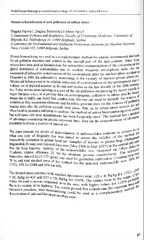Приказ основних података о документу
Mosses as bioindicators of aero pollution in urban areas
| dc.creator | Popović, Dragana | |
| dc.creator | Todorović, Dragana | |
| dc.creator | Ajtić, Jelena | |
| dc.date.accessioned | 2022-03-01T08:23:53Z | |
| dc.date.available | 2022-03-01T08:23:53Z | |
| dc.date.issued | 2008 | |
| dc.identifier.uri | https://vet-erinar.vet.bg.ac.rs/handle/123456789/2432 | |
| dc.description.abstract | Mosses biomonitoring was used as a complementary method for classic instrumental methods for air pollution detection and control in the second part of the last century. Since then, mosses have been used as bioindicators for radioactive contamination of the environment for global distribution of radionuclides due to nuclear weapons atmospheric tests, for the assessment of radioactive contamiruition of the environment after the nuclear plant accident in Chernobyl in 1986, for radioactivity monitoring in the vicinity of nuclear power plants etc. Mosses and lichen proved to be reliable indicators of contamimition of the environment due to military' use of depleted uranium in Bosnia and Serbia in the last decade of the 20th century, too. Today mosses biomonitoring is a part of the air pollution monitoring by heavy metals in major European cities, as it provide data on anthropogenic pollution in urban area by heavy metals due to traffic and fossil fuel combustion. Mosses arc used to identify the sources of pollution as they accumulate elements and therefore provide data on the sources of pollution sources even after the pollution episode took place. But, as in urban areas mosses are not often found in quantities sufficient to analyze, the method of active biomonitoring or so called bag techniques with moss transplantants has been frequently used, The method has a number of advantages considering the precise exposure time, data on the concentrations of elements, possibility to choose a location of interest etc. The paper presents the results of determination of radionuclides contents in mosses in an urban area (city of Belgrade) that was aimed to assess the validity of the method for radioactivity evaluation in ground level air. Samples of mosses in plastic bags (Sphagnum girgensohnii, Russia) were exposed for a year (May 2006 to May 2007) in the central city area near the local highway. Activity of the radionuclides was measured on HPGe detector (Canberra, relative efficiency 23 %) by standard gamma spectrometry. The reference radioactive material IAEA-373 (grass) was used for geometric calibration. Counting time was 58 ks, and total standard error of the method for the detected radionuclide was: 10% for 137Cs, 20% for 210Pb and 16% for 40K. The obtained mean activities (with standard deviations) were; (28 ± 4) Bq/kg for 137Cs, (245 ± 34) Bq/kg for 40K and (315 ± 25) Bq/kg for 2I0Pb. The values were in the range of the values obtained in mosses originated from the area, with higher values for 2I0Pb probably due to the vicinity of the highway. The results proved that considering the exposure time and calibration procedure, moss biomonitoring could be used as a complementary method for determination of radionuclides in air in urban areas. | sr |
| dc.language.iso | en | sr |
| dc.publisher | RVB | sr |
| dc.rights | openAccess | sr |
| dc.source | Book of Abstracts of the Fourth International Symposium on In Situ Nuclear Metrology as a Tool for Radioecology, October 13–16,Rabat, Morocco | sr |
| dc.title | Mosses as bioindicators of aero pollution in urban areas | sr |
| dc.type | conferenceObject | sr |
| dc.rights.license | ARR | sr |
| dc.citation.volume | 86 | |
| dc.identifier.fulltext | http://veterinar.vet.bg.ac.rs/bitstream/id/6748/20220301_001.pdf | |
| dc.identifier.rcub | https://hdl.handle.net/21.15107/rcub_veterinar_2432 | |
| dc.type.version | publishedVersion | sr |

